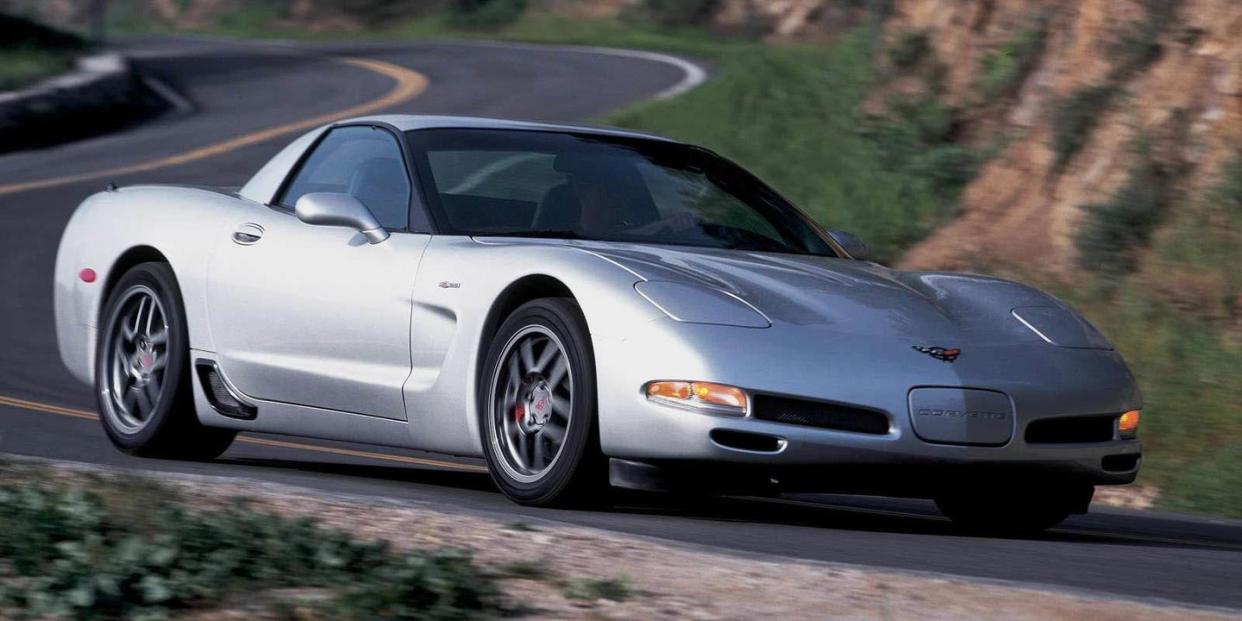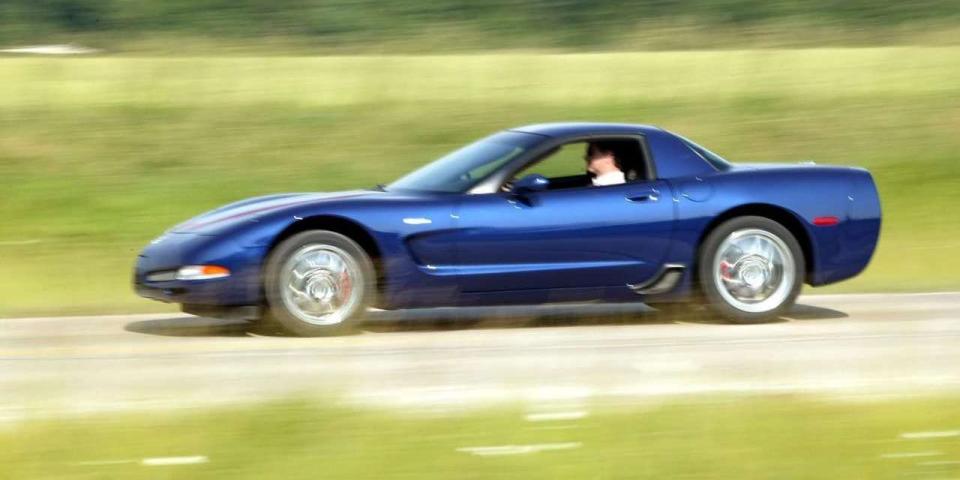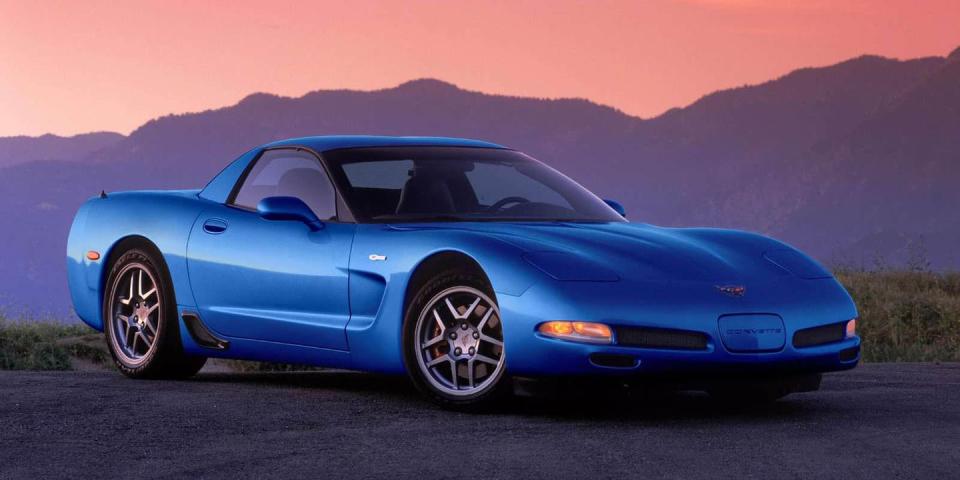Everything You Need To Know Before Buying a C5 Corvette Z06

It's graduation day. After a couple of years spent grinding your entry-level machine around the local track, shaving off seconds and sharpening your skills, it's time to take the training wheels off.
As we've laid out in the past, the best way to "win" an HPDE track day on a budget is to find, purchase, and properly prepare a Corvette Z06. As we also point out, the fifth-generation Corvette is generally seen by the uninitiated as an old man's car. Every one, it is rumored, came from the factory with a Hawaiian shirt and pleated khaki shorts folded neatly in the trunk.
Ignore the haters–the C5 Z06 landed in 2001 running a twelve second quarter-mile out of the box. It is brutally simple, it weighs as much as (and kinda smells like) a scale model kit, and it pulls nearly one g in the corners. Throw a set of decent tires on it, and it will put down numbers that'll have the 911 Turbo and the Nissan GT-R sweating beads of oil.
And, because this is America's supercar, it'll also light up the rear tires, slew around if you jump on the throttle too early, and depreciate like an ice sculpture of a bald eagle. There's almost nothing else that's this fast for the money. Here's how to get one.
What to look for:

The Z06 arrived in 2000 for the 2001 model year with an all-aluminum 5.7L V8 producing 385hp at 6000rpm and 385lb-ft of torque at 4800rpm. In a world where your rental V8 Mustang now makes more than 400hp, these numbers sound relatively modest, but you have to remember it was a different time.
Chevy's fiberglass cruise missile was aimed straight at blasting much more expensive machinery into smithereens. In instrumented testing, it pulled 0.98g on the skidpad, ran to 60 mph in 4.3 seconds, braked from 70mph in 152 feet, and went through the quarter-mile in 12.7 seconds. Holy crap–Hawaiian shirt guy just punched out a dude in a UFC hat!
The first-year cars have the least amount of power of the C5 Z06's run, but don't dismiss them out of hand. If you're going to be bolting on a few upgrades anyway, the 2001 cars are a great place to start, and can often be the cheapest deals.
The base C5 was already a pretty quick car, and along with its LS6-code V8, the Z06 added a few other enhancements. Starting with the fixed-roof coupe version of the basic 'Vette (known as the FRC in Corvette circles), the Z06 had a titanium exhaust, a reduced amount of sound-deadening material, improved suspension, and sharp-looking lightweight wheels; thinner windshield glass was also an option starting for 2002. While the FRC is really neat too, and can be a great basis for a trackday car, it's not very common, and a solid Z06 probably won't be that much more expensive.

In its second year of production, Chevrolet took the LS6 and helped it breathe a little easier. Adding a stiffer, lighter valve train and a more aggressive camshaft profile, the total output was bumped to 405hp at 6000rpm and 400lb-ft at 4800 rpm. 0-60 times dropped to less than four seconds. With a set of really sticky modern performance tires on it, quarter-mile times drop into the low 11s. Goodbye, Hellcat.
For the final year, Chevrolet offered a special commemorative version with the option code Z16, celebrating their back-to-back class wins at Le Mans. More than two thousand Z06s came with this option in 2004, which includes a weight-saving carbonfiber hood, special Le Mans blue paint, a host of badges, and a returned suspension.
The 2004 cracked the Nürburgring's eight minute mark. Nowadays, Porsche claims far faster times than that for its Panamera sedan, but you have to put the Z06's performance into context. It was a different time. For instance, if you turned on the television in 2004, you might catch an episode of The Apprentice, which featured a man named Donald Trump yelling at people. These days, things are completely different.
What to avoid:

Bless GM for continuing to improve the base Corvette by leaps and bounds, while still keeping it relatively inexpensive. The C7 Stingray is vicious enough to tempt many a Z06 owner out of a well-loved, low-mileage ride, just in time for you to snap it up. Unlike a double-duty car like a Mustang or Camaro, a 'Vette might well have never spent a night outside, let alone been driven in the rain.
As per usual with a second hand vehicle, buying a Z06 is as much about gauging the owner as it is about getting a surface read on the car. If said owner is wearing a Blipshift shirt reading "HPDE Champion," and tries to tell you he's never tracked the car, that's probably a fib. But don't make any ageist assumptions either–plenty of old guys can and do cane the ever-loving bejesus out of their cars.
Having found a car that looks like it hasn't been thrashed, there are a few problem areas to look for before paying for a pre-purchase inspection. First, look for body damage in the usual manner, checking for overspray and the like. Indications that a panel has been replaced can be found by checking for worn screws: check the hatch and pop the hood.
Checking under the car, chances are you're going to find some scraping. The Z06 is pretty low, and the underside will likely be chewed up a little. Double check the rocker panels for any serious damage and cracking, whether from impacts or improper jacking.

The interior of even the most well-loved Z06 will likely look pretty shoddy. The early 2000s were not GM's strongest time for build quality, and things break. You can get a partial read on how well an owner has cared for the car by checking out the seat bolsters for excessive wear; leather seats in this generation are prone to cracking. Also, watch for a faulty LED indicators in the HVAC gauges.
Checking all the gauges is a good idea. If the oil-pressure gauge is stuck reading high, it can indicate a failure of the oil pressure sending unit. It's a cheap part, but you have to pull off the intake manifold to get at it.
While you're in there, you can check the Z06's onboard diagnostic system for past errors. Turn the car on but don't start it. Clear the dash by pressing the Reset button, then press and hold the Option button; while holding, press the Fuel button four times. Activate manual mode by pressing any of the right side buttons (except E/M, which closes the session), and use the Options and Trip buttons to scroll through the codes. A C after a code indicates a current problem, an H means it's part of the car's past. Write everything down, then sprint to the internet to see if anything serious is in there.
The other major issue with the C5's interior is the lockout for the steering column. As a theft-deterrent, the C5 will lock down the steering if it detects something it thinks isn't the ignition key. Problem is, it's way too sensitive and can lock you out of your Corvette if you put your key in just a little wrong. There are a bunch of recalls for this issue and an option to just delete the lockout. Ask the owner if it's been dealt with.
Even if you're going to swap in a set of track-focused tires as soon as you get the car home, it's worth taking a look at those tires. Original equipment on the Z06 calls for run-flats, which can be expensive. Look for wear on the inners, and factor the cost into your bargaining.
Mechanically-speaking, the Z06 is very robust, but has a few mechanical issues that are difficult to diagnose without a thorough pre-purchase inspection from an experienced 'Vette specialist. 2001 and some early 2002 models can suffer from excessive oil consumption. The lighter valvetrain in the 2002 and 2003 models can result in broken valve-springs–if the owner has modified the valve springs for more durable units, this can be a boon.
A note on modifications:

Being a twelve year old performance car with a large aftermarket, it's likely the Z06 you're looking at is going to have some non-factory parts. If you're going to be tracking the car, these are generally no big deal, especially small, useful power-adding stuff, or replacement of worn bushings with polyurethane units.
As far as your own plans for the car:
1.) It's a Chevy V8.
2.) This is America, pal.
Having said that, making big power out of a C5 Z06, while not particularly difficult, might not be your first focus–it's pretty damned fast as is. Adding extra cooling for the transmission and/or engine will help you run laps for longer. Upgrading to high-temp brake pads and brake and clutch fluid that can take the heat at the track is a minimum. You might consider a big-brake kit as well, but since this is budget speed, maybe focus on learning a little brake management first.
As mentioned, run-flats for the Z06 will set you back a pretty penny, especially for the rears. An alternative is to just swap in normal tires, and purchase a small chicken to sacrifice in appeasement of the god of flat tires, Puncturus.
Community:

The fifth-generation Corvette is very well supported on forums, and there's a wealth of information to be found on the Z06 specialists in them. Corvetteforum.com has a specific section on C5 Z06 technical info.
Don't be too quick to dismiss your local Corvette club as a show n' shine only crowd either. Like any sportscar fraternity, there are those more interested in polishing chrome rims than checking tire pressures, but Corvette clubs are often built on a spine of genuine racing enthusiasts, many of whom know a trick or two the internet crew has yet to discover.
This guide was originally published on 7/19/16 and has been updated.
You Might Also Like

